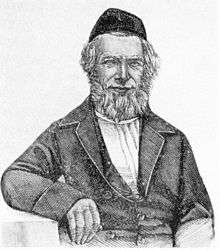Jacob Ettlinger
| Jacob Ettlinger | |
|---|---|
 Rabbi Jacob Ettlinger | |
| Born |
17 March 1798 Karlsruhe, Baden |
| Died |
7 December 1871 (aged 73) Altona, Prussia |
| Nationality | German |
Jacob Ettlinger (17 March 1798 – 7 December 1871) (Hebrew: יעקב עטלינגר) was a German rabbi and author, and one of the leaders of Orthodox Judaism. He is sometimes referred to as the Aruch la-Ner (ערוך לנר) because of his noteworthy publication by that same name.
Personal information
He was born at Karlsruhe, Baden, and died at Altona, Prussia. He received his early education from his father Aaron, who was Klausrabbiner (Rabbi of a small synagogue) in Karlsruhe, continuing his studies under Abraham Bing at Würzburg, where he also attended the university. He was thus among the earliest German rabbis who possessed academic training. In 1826 he was appointed Kreisrabbiner (district rabbi) of Ladenburg, with his seat in Mannheim, where he was at the same time chief prebendary (Klausprimator). This position he held until he succeeded Akiba Israel Wertheimer as Chief Rabbi to Altona, where he officiated from 1836 until his death. His ambit as Ashkenazi Chief Rabbi comprised Holstein and Schleswig and until 1864 also Denmark. In this position he became one of the most prominent representatives of German Orthodoxy, which stood for investigation of all aspects of secular learning through the lens of Torah (Written and oral traditions), and accepting those aspects deemed true.
Education
A typical story is reported by Abraham Geiger, who formed Ettlinger's acquaintance as a student in 1829. At a school examination a teacher said that Joseph's brothers had acted in an unbrotherly fashion, whereupon Ettlinger rebuked him indignantly for speaking ill of the Twelve Tribes of Israel. His views can be judged from his first work, Bikkurei Yaakov, in the preface of which he says that he chose this title because it had the numerical value of Jacob and Rachel, who are mystically represented in the law of the Sukkah, with which the book deals. A similar belief in the doctrines of the Kabbalah is expressed in a sermon in which he urged early burial, because as long as the body remains unburied evil spirits have power over it. In his will he left the request that the four capital punishments (stoning, burning, decapitation and asphyxiation) should be performed symbolically on his body.
Protests
Ettlinger became one of the strongest opponents of the early Reform Judaism movement, and headed a protest of 173 rabbis against the Brunswick Conference of 1844. In the following year he established the first organ of Orthodox Judaism, Der treue Zionswächter, Organ zur Wahrung der Interessen des gesetzestreuen Judenthums with a Hebrew language supplement, Shomer Tziyon ha-Ne'eman, edited by S. J. Enoch.
His yeshiva was attended by a great many students preparing for the ministry, and many of them became leaders of Orthodoxy. Samson Raphael Hirsch was his disciple in Mannheim, and Israel (Esriel) Hildesheimer in Altona. Four of his sons-in-law became prominent Orthodox rabbis: Joseph Isaacsohn of Rotterdam, Salomon Cohn of Schwerin, Israel Meir Freimann of Ostrowo, and Moses Löb Bamberger of Kissingen. He was the last German rabbi who acted as civil judge. Much against his will, the Danish government, to which Altona then belonged, abolished this right of the Altona Rabbi in 1863. The purity of his character and the sincerity of his religious views were acknowledged even by his opponents. He provided in his will that nobody should call him "Tzaddik" (righteous), and that the inscription on his tombstone should contain merely the titles of his works and a statement of the number of years during which he was rabbi of Altona. The congregation obtained permission from the government to bury him in the old cemetery of Altona, which had been closed a year before.
Works
His published works are:
- Bikkurei Yaakov (ביכורי יעקב), on the laws of Sukkot, Altona, 1836 (2d ed. with the addition of Tosefot Bikkurim, Altona, 1858)
- Aruch la-Ner (ערוך לנר), glosses on various Talmudic treatises (on Yevamot, Altona, 1850; on Makkot and Keritot, Altona, 1855; on Sukkah, Altona, 1858; on Niddah, Altona, 1864; on Rosh ha-Shanah and Sanhedrin, Warsaw, 1873)
- Binyan Tziyon (בנין ציון), responsa, Altona, 1868; She'elot u-Teshuvot Binyan Tziyon ha-Chadashot, Wilna, 1874 (a continuation of the preceding);
- Minchat Ani (מנחת עני), homilies, Altona, 1874

He published various sermons in German, among them Antrittsrede, Gehalten in der Grossen Synagoge zu Altona, Altona, 1836; Rede beim Trauergottesdienst beim Ableben Friedrich III, Altona, 1840; and numerous articles in the Treue Zionswächter, a collection of which was published by L. M. Bamberger, Abhandlungen und Reden, Schildberg, 1899
Bibliography
- Bleich, Judith (1974). Jacob Ettlinger, his Life and Works: The Emergence of Modern Orthodoxy in Germany. Phil. Diss. New York. OCLC 6739470.
References
-
 This article incorporates text from a publication now in the public domain: Isidore Singer, Gotthard Deutsch (1901–1906). "Ettlinger, Jacob". In Singer, Isidore; et al. Jewish Encyclopedia. New York: Funk & Wagnalls Company.
This article incorporates text from a publication now in the public domain: Isidore Singer, Gotthard Deutsch (1901–1906). "Ettlinger, Jacob". In Singer, Isidore; et al. Jewish Encyclopedia. New York: Funk & Wagnalls Company.